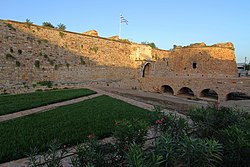
Chios is the fifth largest Greek island, situated in the northern Aegean Sea, and the tenth largest island in the overall Mediterranean Sea. The island is separated from Turkey by the Chios Strait. Chios is notable for its exports of mastic gum and its nickname is "the Mastic Island". Tourist attractions include its medieval villages and the 11th-century monastery of Nea Moni, a UNESCO World Heritage Site.

The fall of Constantinople, also known as the conquest of Constantinople, was the capture of the capital of the Byzantine Empire by the Ottoman Empire. The city was captured on 29 May 1453 as part of the culmination of a 53-day siege which had begun on 6 April.
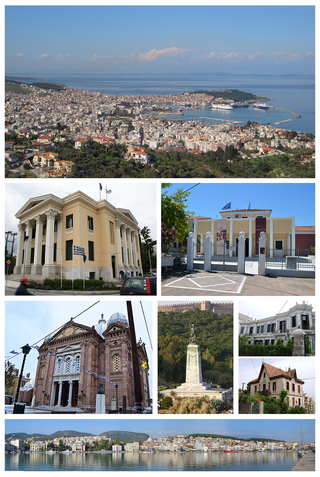
Mytilene is the capital of the Greek island of Lesbos, and its port. It is also the capital and administrative center of the North Aegean Region, and hosts the headquarters of the University of the Aegean. It was founded in the 11th century BC.

Galata is the former name of the Karaköy neighbourhood in Istanbul, which is located at the northern shore of the Golden Horn. The district is connected to the historic Fatih district by several bridges that cross the Golden Horn, most notably the Galata Bridge. The medieval citadel of Galata was a colony of the Republic of Genoa between 1273 and 1453. The famous Galata Tower was built by the Genoese in 1348 at the northernmost and highest point of the citadel. Galata is now a quarter within the district of Beyoğlu in Istanbul.
Giovanni Giustiniani Longo was a Genoese nobleman, captain, and defender of Constantinople during its siege in 1453. He was instrumental in its defense and commanded 700 men, as well as leading the land forces protecting the city.
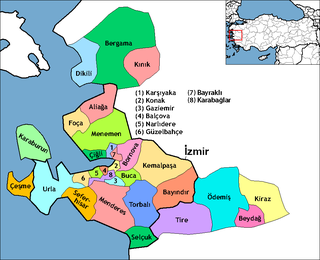
Foça is a town and district in Turkey's İzmir Province, on the Aegean coast. The town of Foça is situated at about 69 km (43 mi) northwest of İzmir's city center. The district also has a township with its own municipality named Yenifoça, also along the shore and at a distance of 20 km (12 mi) from Foça proper. For this reason, Foça itself is locally often called as Eskifoça in daily parlance. The town is built on the site of the ancient Greek city of Phocaea.
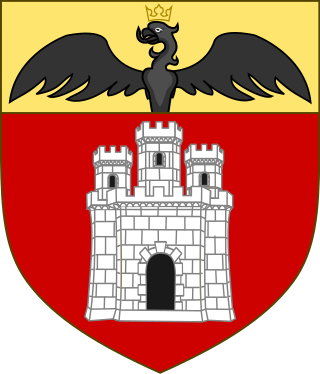
The House of Giustiniani was the name of a prominent Italian family which originally belonged to Venice, but also established itself in Genoa, and at various times had representatives in Naples, Canary Islands, Corsica and in the islands of the Archipelago, where they had been the last Genoese rulers of the Aegean island of Chios, which had been a family possession for two centuries until 1566. The family claimed descent from Byzantine emperor Justinian I.

Marchese Vincenzo Giustiniani was an aristocratic Italian banker, art collector and intellectual of the late 16th and early 17th centuries, known today largely for the Giustiniani art collection, assembled at the Palazzo Giustiniani, near the Pantheon, in Rome, and at the family palazzo at Bassano by Vincenzo and his brother, Cardinal Benedetto, and for his patronage of the artist Caravaggio.
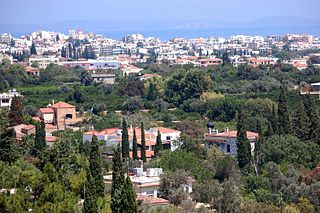
Chios is the main town and a former municipality on the island of Chios, North Aegean, Greece. Since the 2011 local government reform, it is part of the municipality Chios, of which it is a municipal unit. The municipal unit has an area of 22.823 km2. It is located on the eastern coast of the island facing the Turkish coastal town of Çeşme. The town has a population of 26,850 (2011) and is the administrative capital and main port of both the island and of the regional unit of Chios. Chios town is one of eight municipal units on the island.
Leonard of Chios was a Greek scholar of the Dominican Order and Latin Archbishop of Mytilene, best known for his eye-witness account of the Fall of Constantinople in 1453, which is one of the main sources for the event.

Selimiye Mosque, historically known as Cathedral of Saint Sophia or Ayasofya Mosque, is a former Christian cathedral converted into a mosque, located in North Nicosia. It has historically been the main mosque on the island of Cyprus. The Selimiye Mosque is housed in the largest and oldest surviving Gothic church in Cyprus possibly constructed on the site of an earlier Byzantine church.

Maona of Chios and Phocaea was a maona formed to exact taxes for the Republic of Genoa from the island of Chios and port of Phocaea. Genoa sold the rights to their taxes to the maona, which raised funds from its investors to buy galleys and eventually re-conquer Chios and Phocaea.

The Lordship of Chios was a short-lived autonomous lordship run by the Genoese Zaccaria family. Its core was the eastern Aegean island of Chios, and in its height it encompassed a number of other islands off the shore of Asia Minor. Although theoretically a vassal of the Byzantine Empire, the Zaccaria ruled the island as a practically independent domain from its capture in 1304 until the Greek-Byzantines recovered it, with the support of the local Greek population, in 1329. The island would return to Genoese control in 1346 under the Maona of Chios and Phocaea.

Nea Moni is an 11th-century monastery on the island of Chios that has been recognized as a UNESCO World Heritage Site. It is located on the Provateio Oros Mt. in the island's interior, about 15 km from Chios town. It is well known for its mosaics, which, together with those at Daphni and Hosios Loukas, are among the finest examples of "Macedonian Renaissance" art in Greece.

The Frankokratia, also known as Latinokratia and, for the Venetian domains, Venetokratia or Enetokratia, was the period in Greek history after the Fourth Crusade (1204), when a number of primarily French and Italian states were established by the Partitio terrarum imperii Romaniae on the territory of the dissolved Byzantine Empire.
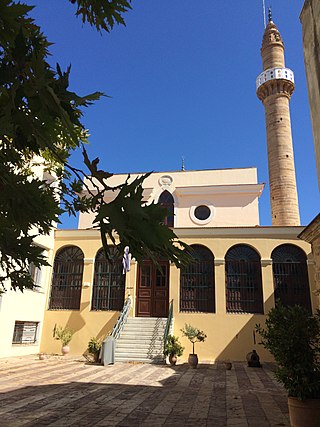
The Chios Byzantine Museum is a museum in Chios, Greece, housed in an Ottoman-era mosque that was known as the Mecidiye Mosque.
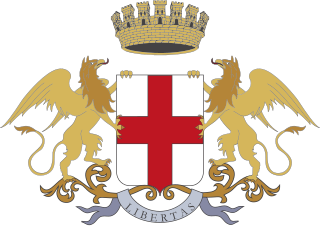
Pietro Campofregoso was Doge of Genoa from 1450 to 1458.

The Ioannina Castle is the fortified old town of the city of Ioannina in northwestern Greece. The present fortification dates largely to the reconstruction under Ali Pasha in the late Ottoman period, but incorporates also pre-existing Byzantine elements.

The architecture of Albania is a reflection of Albania's historical and cultural heritage. The country's architecture was influenced by its location within the Mediterranean Basin and progressed over the course of history as it was once inhabited by numerous civilisations including the Illyrians, Ancient Greeks, Romans, Byzantines, Venetians, Ottomans as well as modern Austro-Hungarians and Italians. In addition, missionaries, invaders, colonisers and traders brought cultural changes that had a large profound effect on building styles as well as techniques.

Mesta is a Greek traditional village on the island of Chios. It belongs to the Mastic Villages, a group of villages in South Chios where the main activity is the manufacture of mastic. The mastic villages have been added to the representative List of the Intangible Cultural Heritage of Humanity of UNESCO. Mesta is characterised by particular architecture since it is a village-castle with perfectly preserved medieval architecture. Mesta is located 35 km south west of Chios (town), 4 km away from the coast. It is built at a height of 120m and it belongs to Chios municipality and Mastichochoria municipal unit. It is also a community that comprises the village Limenas where the port of south west Chios is located.
